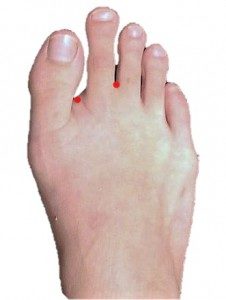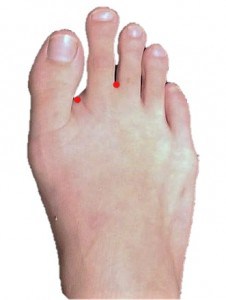Toes are funny things. There are short toes, long toes, wide and skinny toes. The ones that cause most people grief are the ones that are crooked and don’t look like they fit your foot. Some crooked or “funny looking” toes are quite natural and you were probably born with them. Morton’s Toe, where the second toe is longer than the big toe is one example.
What is Morton’s Toe
Not usually a functional problem, a Morton’s Toe (named for Dudley Morton, an orthopedic surgeon who described the condition in a 1928 article) is usually the result of the first metatarsal – the bone in your forefoot – being shorter than the second metatarsal. In essence, Morton’s toe is not a longer second toe, it is in fact, a shorter first toe.

Can a Morton’s Toe Cause Problems?
A minor Morton’s toe is generally non-symptomatic. A pronounced Morton’s toe like the one in the picture can alter the balance of force during gait, resulting in excess pressure on the ball of the foot or on the second toe. This altered balance can cause a problem when thick calluses or corns form under the ball of the foot or on the end of the toe.
The normal balance of the foot means that your big toe should take anywhere from 40%-60% of the force during the “push off” phase of gait. This phase of gait occurs just as the toes of one foot are pushing off the ground and before the other foot hits the ground. Because of the short first metatarsal, force is transferred to the second (Morton’s) toe, causing greater pressure under the toe resulting in calluses.
One other common problem is to have the longer toe develop into a hammertoe with the middle joint of the toe assuming a bent position. This is generally a response to the toe being pushed against the end of the shoe. This in essence shortens the toe, but unfortunately a hammertoe can cause other problems. (For more information, read our conditions page on hammertoes )
Treatment for Morton’s toe?
The answer to most foot problems: choose the right shoes. This advice is the same for those with Morton’s toes. The right footwear includes shoes with a wide and deep toe box, the area where your toes rest. Properly positioned metatarsal pads worn in your shoes can help relieve pressure and may alter the mechanics of your foot enough to promote better foot balance. Custom molded orthotic inserts can promote proper foot alignment and may incorporate pads that relieve or reassign the pressure on the ball of your foot.
If you have a pronounced Morton’s toe, consider seeing a Podiatrist or other foot specialist who can help you determine what pads or orthotics will work for you. What you don’t want to do is add pads or an off the shelf orthotic without knowing how they will affect your gait. Altering how you walk could potentially transfer stress onto other joints including your ankles, knees and hips. The right pad in the right place could do wonders when combined with a roomy shoe that let’s your toes find the best balance for you.
Like what you’ve read? Click here to subscribe to the blog!
Our blogs are educational in nature and are not intended as a substitute for medical advice. Because your condition is unique to you, it is recommended that you consult with your health care provider before attempting any medical or therapeutic treatments. We are always happy to answer questions about products mentioned in our blogs, however, we cannot provide a diagnosis or medical advice.


My Morton’s toe has definitely caused it to develop hammer toe which is now so severe that I have to have surgery.
I LOVE my little big toe!
I believe that my toes are crooked. It’s interesting to know that I actually have Morton’s toe, and that’s the reason why I have crooked toes. Since I don’t want it to fully develop into hammertoes, I’ll have a cosmetic to surgery done by a good clinic that offers it.